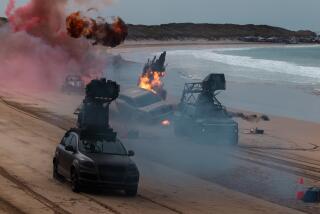He can make the wind blow
In THE special-effects world, you’ve got your flashy, big-explosion guys, and then there’s Steve Cremin. Although he’s worked on some pretty high-profile movies -- “Jarhead,” “There Will Be Blood,” and mostly recently, M. Night Shyamalan’s “The Happening” -- the 51-year-old effects coordinator isn’t looking to overwhelm audiences. “I make sure that I don’t upstage anything with the effects,” he says. “I’m not obtrusive.”
Cremin, who was born in Toronto and attended UC Santa Barbara, started his career in showbiz after falling into stunt work one summer when he signed up to be an extra on “The Love Boat.” “They were doing a steeplechase and needed people to [double as riders],” he recalls. As a trained horseman, he got the gig. That stint led to more than a decade in the stunt game. But after he decided the field was too risky, he went into effects instead.
It’s his unobtrusiveness that made Cremin a natural fit for Shyamalan’s films. Most memorable of his work on 1999’s “The Sixth Sense” was the practical cold breath effect (which occurred whenever a character was in a room with a dead person). “Everyone thought that was [computer generated],” he says. “We did it for real. We built a cold room where we could drop the temperature within like 12 minutes.”
Forces of nature play a major role in “The Happening,” starring Mark Wahlberg and Zooey Deschanel. In the movie, mysterious winds wreak havoc over humanity, and Cremin was in charge of creating the bluster.
Fan club: To create different gradations of air streams, Cremin and his crew used a variety of machines. The biggest was a 500-horsepower monstrosity that could generate 100 mph of wind 70 feet away. “There were two of them, actually, in L.A. that were built for [the 2006 film] ‘The Guardian,’ ” says Cremin. “They’re pretty much the biggest engines and the highest-output working machines. A friend of mine owned one, and he didn’t really like renting it out, so I ended up buying the machine so I could use it.” What does he do with his oversize purchase after the shoot? “I just let my kids play with it,” he jokes.
Thar she blows: Cremin says it’s important to focus on strategic spots to create a wind scene that works, “because motion is what catches your eye.” So he would add leaves to the Pennsylvania shoot or sprinkle dust in the air -- anything that would help convey movement. The same went with actors. “If the guy has a shaved head, you can pretty much phone it in,” Cremin says. “We love blonds with really wispy hair, because it can look like a hurricane with the smallest fan in the world.” Deschanel got high marks for her locks. “Zooey was a dream because her hair was long and it moves really well,” Cremin says. “I don’t remember that it was always down for the movie, but I know that in the critical parts it was, and we played it to the hilt.”
On the fly: Cremin was forced to use unconventional methods when a scene called for the wind to chase a group of characters. At first, “I was a little puzzled, like, it’s going to be like a huge rig of cranes and all kind of stuff,” he says. “And the next meeting, I was like, ‘I’m thinking of helicopters.’ And everybody looked at me, like how your dog would look at you if you whistled at a really high pitch.” Cremin had to make sure the twin-engine aircraft swooped down at just the right angle so the whirling blades could create the desired effect. “When they hover they just look like wind,” he explains. “You get them [flying] at just the right height and just the right speed, and it kind of looks like a wind storm coming in.”
Night moves: The notoriously secretive Shyamalan uses computer-generated images only as a last resort and depends on his effects team to come up with some creative solutions. “He’s one of the guys who calls me the doctor, so I think he kind of figures that I can figure stuff out,” Cremin says. “As much as he plans things, he still gets a little bit of a kick coming up with stuff on the spot and seeing what I can come up with.”
Cremin aims to please: “We’d give him dailies and he would give a nod and he’d go, ‘Oh, that’s good. Was that God’s wind or Steve’s wind?’ ” he recounts. “And I would hardly ever answer him, because it’s like, you know what? If you can’t tell, then I did my job.”
More to Read
Only good movies
Get the Indie Focus newsletter, Mark Olsen's weekly guide to the world of cinema.
You may occasionally receive promotional content from the Los Angeles Times.






